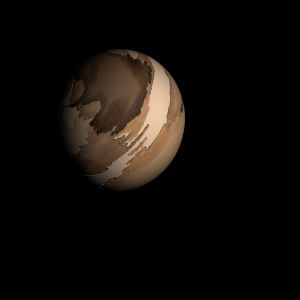|
|
Space Astro
|
Info for exoplanet "Ajuhe Nepo"
| Scientific (actual) data |
|---|
| Name | TOI-1669 b |
| Planet status | Confirmed |
| Planet mass | 0.0132 |
| Radius | 0.214 |
| Orbital period | 2.68005 |
| Discovered | 2022 |
| Updated | 2022-09-16 |
| Publication | Published in a refereed paper |
| Detection type | Primary Transit |
| Mass measurement type | Radial Velocity |
| Radius measurement type | Primary Transit |
| Star name | TOI-1669 |
| Right ascension | 45.95° |
| Declination | 83.59° |
| Mag v | 10.3 |
| Star distance | 111.75 |
| Star sp type | G5 |
| Wikipedia article | TOI-1669 b |
Back
| |
| Fictional info (?) |
|---|
| Suggested name | Ajuhe Nepo |
| Planet type | Cold planet |
| It is the coldest planetary atmosphere in its solar system, with a minimum temperature of 28°K (-245°C), and has a complex, layered cloud structure with ammonium hydrosulfide (NH4SH) thought to make up the lowest clouds, and water vapor the uppermost layer of clouds.
It is radically different from Earth in other respects.
The smooth Borealis basin in the northern hemisphere covers 33 percent of the planet and may be a giant impact feature. |
| Atmosphere | Water vapor | 98% |
| Ammonium hydrosulfide (NH4SH) | 1.3% |
| Sulfur dioxide | 0.34% |
| Hydrogen deuteride (HD) | 0.0055% |
| Atmospheric pressure | 2.1 bar |
 |
| No known satellites |
| Google search for Ajuhe nepo |
|
Website by Joachim Michaelis
|
|
|
|